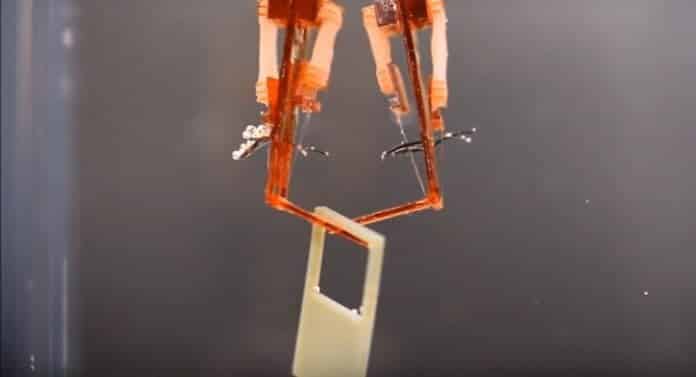Researchers Build Cyborgs Using Lab-Grown Muscles
Almost human – advances in “biohybrid” is set to break history with a biomechanical robot that functions like humans.
“Metal robots will soon have the flexibility of the human arm,” says the researchers at the University Tokyo’s Institute of Industrial Science after revealing a biohybrid robot that mimics the hand functions of humans.
In their experiments, scientists have managed to graft a living muscle from a real human finger and integrated it into a robotic device. By manipulating muscle control and neural signals, they have developed a unique command system that allows the robot to work.
The “biohybrid” robot adapts the artificial finger bone to pick up and drop a ring. It contracts and rotates in two directions like the normal human biceps and triceps. The invention has remained functional for over a week now.
The birth of biohybrid robots
Using a 3D-printed resin, scientists first built a robot skeleton with joint and anchors, in which the living tissue is ought to be attached.
After putting up an artificial skeleton, scientists created a living muscle tissue through a myoblast – a type of stem cell that multiplies into different muscle cells. After the process
, they utilized hydrogel sheets to pick up tiny muscle fibers and attached them into the tiny holes of the robot’s anchors and allowed them to grow.Author of the report, Shoji Takeuchi says that the robot’s structure resembles the muscles in a human being’s forearm. “Using electrodes, we were able to stimulate the living muscles in the robot causing it to contract, expand, and rotate.”
Not the first study
According to Takeuchi, this is not the first experiment where they have built a hybrid robot. A similar study has already been done in the past using the same procedure. However, the cultivated muscles from previous experiments shrunk quickly and lasted for only a week.
“So now, we are using the muscles as antagonistic pairs to produce opposing force, which prevented them from shrinking,” says Takeuchi. “The opposing force helps the muscle to contract and expand just like the human hands.”
The robot’s signature move is bending its fingertip, which is unique among the many biohybrid robots that the scientists have developed. It bends enough to pick up a ring and places it on a peg within seven seconds.
“Working in harmony, two bots can be used to clip and lift a small square tab in just 10 seconds,” says Takeuchi.
Ambitious future application
According to Takeuchi, engineering a biohybrid finger is not enough to efficiently accomplish tasks like picking and lifting heavy objects.
However, the researchers at the Institute of Industrial Science in Tokyo will be using their new invention to further understand the mechanisms of the human body. Takeuchi is hopeful to integrate more human muscles in the bot to allow a complex muscle interplay.
Another future application would be building a biohybrid robot that will replace animals and humans as subjects for drug testing. Instead of using live organisms, scientists will conduct clinical trials on biohybrid robots – a dream come true for pharmaceutical industries.
Right now, the muscle tissues can only survive in water. Scientists are still probing more ways to resolve these problems such as building motor neurons into the muscle so they can last longer than one week.






























